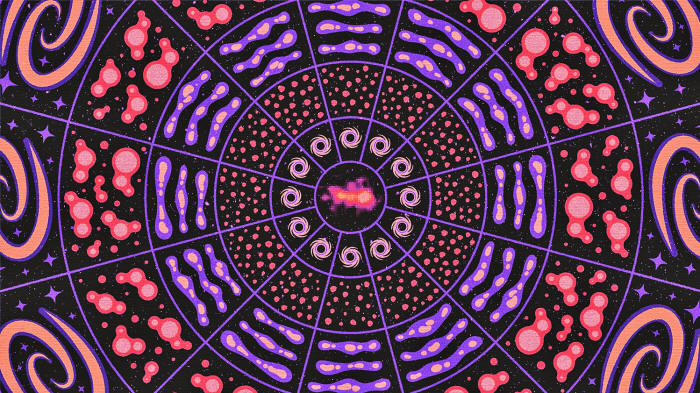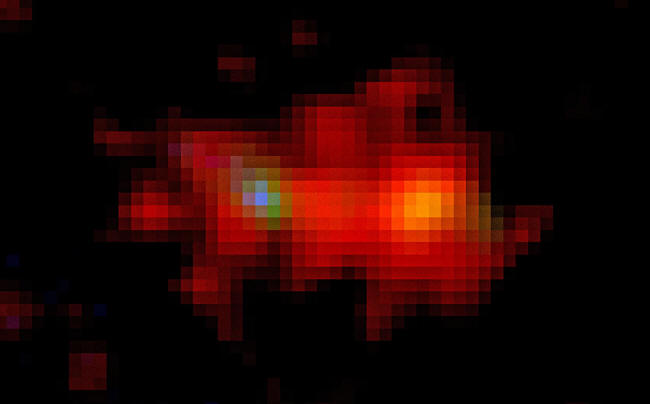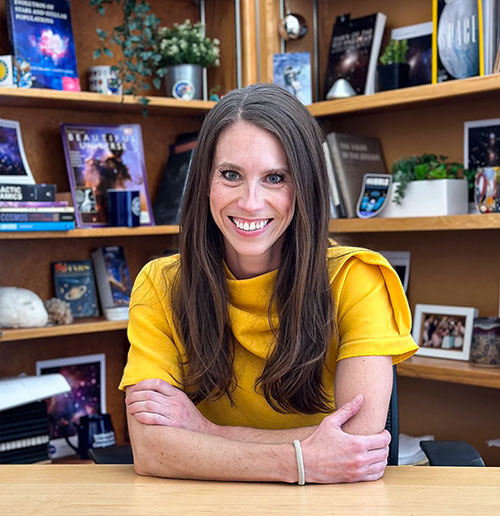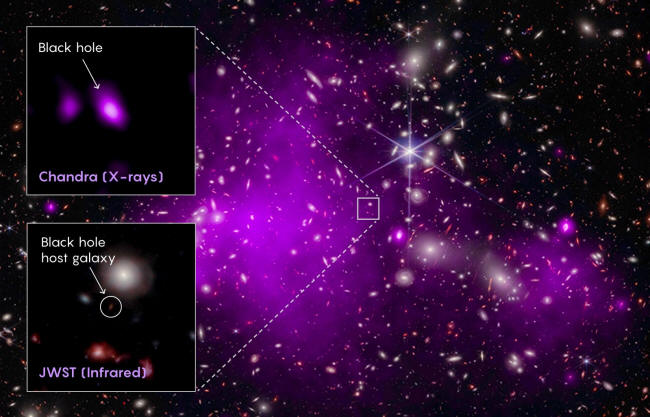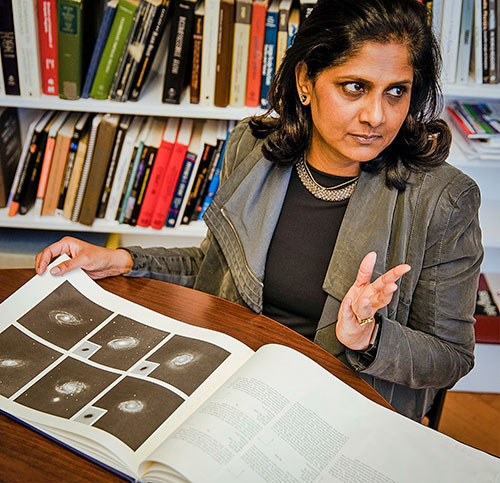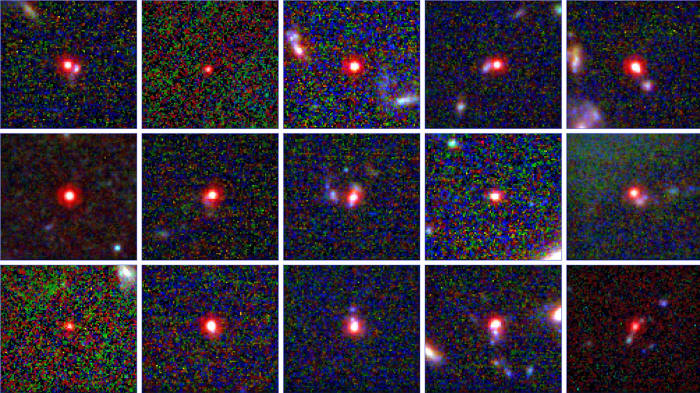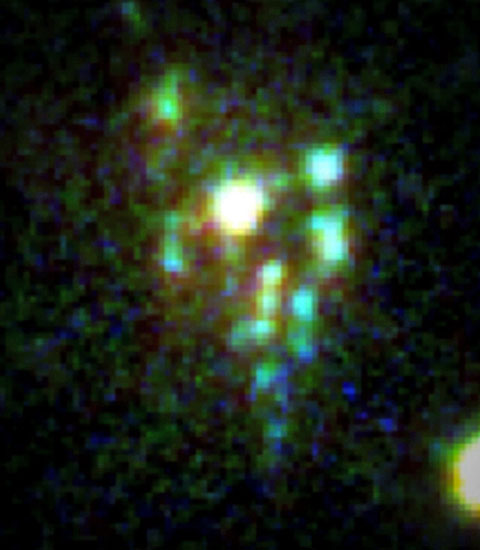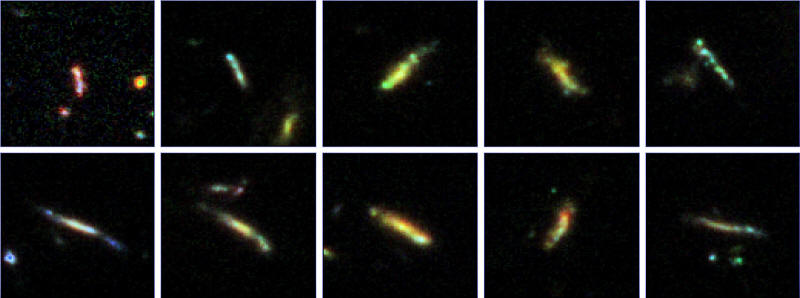|
by Rebecca Boyle from QuantaMagazine Website
Unexpectedly bright galaxies, mysterious little red dots, surprisingly massive black holes, and galaxies shaped like pickles or bunches of grapes have been spotted
all over the young
universe.
James Webb Space Telescope's discoveries about the formative epoch of cosmic history.
converge at a central point and different types of astronomical objects form concentric circles around that point.
And these findings have raised a lot of questions.
In August, Hainline and other researchers came together at the Kavli Institute for Theoretical Physics (KITP) in Santa Barbara, California, to hash them all out.
After the first morning of the conference, I found Hainline in the courtyard.
The new discoveries I had been hearing about seemed revolutionary, perhaps even paradigm-shifting. I wanted to check my reaction with one of the people doing the actual work.
Were these results as extraordinary as I, a reporter, thought they were?
In Santa Barbara, they did. Over star-studded slide decks and rounds of Pacifico beer, 100 or so astrophysicists exulted in the new findings about the universe's first billion years, an epoch that JWST is revealing in exquisite detail for the first time.
They shared surprising observations of "little red dots," which abound in JWST data and whose nature remains elusive, as well as images of other early galaxies that look extremely blue.
They marveled at odd galactic shapes, including bright objects that resolve into tight clusters, like bunches of grapes, and others resembling bananas.
People argued over the enormous black holes spotted at those early times and the circumstances of their formation.
a galaxy spotted in JWST data this year. The universe's earliest known galaxy,
it is
seen as it appeared 300 million years after the Big Bang. Image processing by: Ben Johnson/CfA, Sandro Tacchella Cambridge, and Phill Cargile/CfA
It was like having the optometrist flip a lens so that the last lines on an eye chart come into focus.
People chuckled and
nodded.
These objects are too
faint and at the wrong wavelengths to be seen by previous
observatories, like the Hubble Space Telescope.
an astrophysicist who specializes in galaxy formation and evolution at the University of Texas, Austin, is trying to understand how galaxies grew so bright
so early in cosmic history.
The astrophysicist Rachel Somerville, who co-organized the meeting, said the community is scrambling to absorb both JWST's data and its implications.
Observers see things that are not explained in current theories about the evolution of the young cosmos.
To punctuate the confusion astronomers feel about this once-in-a-lifetime telescope upending what we know of the young universe, he flashed up a tongue-in-cheek slide:
The Biggest and the Brightest
Astronomers kept referring to one of the most consequential galaxies seen so far, an unexpectedly bright smear of light called, dryly, JADES-GS-z14-0.
Hainline, at the University of Arizona, is part of the team that discovered it with JWST and confirmed its distance in May 2024. It is the earliest known galaxy, knocking down the previous record holder, which was found by the same team in 2023.
At the time the galaxy shone forth, sound waves from the tremendous clap that started the universe were still ringing through the void. The first stars had been born in a cataclysmic baby boom, and some had already died.
The dark hearts of black holes lurked, too - regions of space where gravity is so strong that not even light can escape. And there was this cluster of stars, resolved as a fuzzy scorpion shape in JWST filters.
Two instruments on JWST were able to distinguish JADES-GS-z14-0's brightness and its distance from Earth.
Because of the accelerating expansion of the universe, objects at great distances are very far back in time. Astronomers can tell their ages based on the stretching of their light into longer wavelengths, known as redshift.
Based on the most recent measurements, the galaxy was determined to lie at a redshift of 14.18, which means we see it as it appeared 300 million years after the Big Bang - when the universe was about 2% of its current age.
Kevin Hainline of the University of Arizona is part of a team that uses the James Webb Space Telescope
to find and
characterize galaxies at high redshifts.
Initially, astronomers speculated that such huge, bright things so early in the universe were at odds with the prevailing theoretical model of the cosmos.
But people have softened on that claim. Our best model of the universe - a set of equations describing the evolution of matter and radiation along with dark energy and dark matter - is not dead yet.
Astrophysicists are coalescing around three star-based theories for how galaxies grew so bright so fast.
One holds that stars during the cosmic dawn were very different from stars today. The stars in JADES-GS-z14-0, for instance, might be ultrabright but not actually very massive. While this seems plausible, it is also tricky for theoretical modelers to deal with.
The correlation between a star's brightness and its mass is a key value entered into computer simulations.
If this value - known as the initial mass function, or IMF - was different in the early universe, then researchers would have to rewrite their simulations to be able to accommodate an IMF that changes over time.
But nature doesn't care about our computing issues, and a changing IMF is, in principle, one of the most logical ways to make sense of what we see.
Another theory holds that the extra-bright early galaxies happened to be undergoing furious bursts of star formation.
Over 10 million or 100 million years, galactic brightness could vary by a factor of 100 as star formation ramped up and down. That's like a candle turning into a floodlight in the span of a few seconds.
Relatedly, during these busy spells, supernova explosions might have made things look brighter than they would otherwise appear.
Erica Nelson, an astrophysicist at the University of Colorado, Boulder, is part of the JADES team, which has used JWST to spot bright, massive galaxies that existed unexpectedly
early in
cosmic history.
The third theory suggests that star formation was way more efficient then than now.
In a typical galaxy today, a small fraction of the gas is forged into stars; the Milky Way builds between two and six sun-size stars a year.
Some calculations suggest an almost 100% rate of conversion from gas to star, meaning fast and furious stellar birth, said Pratika Dayal of the University of Groningen in the Netherlands.
All these alterations to existing theory come with side effects, like changes in how much dust there should be and puzzles about how stellar baby booms settled down. And they're not even the only ideas out there.
Andrea Ferrara, a cosmologist at the Scuola Normale Superiore in Pisa, Italy, showed his colleagues in Santa Barbara a new model that tries to explain the bright early galaxies by changing the amount of dust within them, which would typically block starlight.
His model assumes that more dust used to be blown away by stellar winds. "Reducing dust attenuation is my favorite hypothesis, even though I am totally open to having the other two," he told attendees.
But, he acknowledged, his calculations might not hold up at a redshift of 14, meaning they might not work for galaxies like JADES-GS-z14-0.
Big Black Holes
Star-related theories are not the only ideas.
Some astrophysicists point to active supermassive black holes, which they say might heat surrounding gas and cause galaxies like JADES-GS-z14-0 to appear extremely bright.
In a series of papers published in May, the JADES team argues that the galaxy is starry, and that its brightness cannot be explained by black holes.
But other galaxies do have such dark hearts. We know supermassive black holes weighing hundreds of millions or billions of suns anchor the centers of modern galaxies.
And JWST is seeing smeared light from many early galaxies, indicating that their gas, too, is being slung around by a central supermassive black hole.
How, then, did the big black holes get there?
Since black holes were first predicted as a consequence of Albert Einstein's theory of gravity, astrophysicists have imagined how they might form from the inward gravitational collapse of dying stars.
They now know that the cosmos is filled with black holes formed in this way.
But cosmologists have struggled to understand supermassive black holes. These black holes somehow grew large enough, and fast enough, to shape the galaxies that formed around them.
If they began as collapsed stars, they would have had to grow at staggering rates that defy physical explanation.
Observations by JWST and the Chandra X-Ray Observatory reveal a supermassive black hole that existed in a galaxy dubbed UHZ1 a mere 470 million years after the Big Bang. Some astrophysicists argue that the black hole, which already had an estimated mass of tens or hundreds of millions of suns, must have formed from the direct collapse
of an enormous gas cloud, rather
than from the death of an individual star. Infrared: NASA/ESA/CSA/STScI Image Processing: NASA/CXC/SAO/L.
Frattare & K. Arcand
This process could produce gargantuan black holes contemporaneous with galaxies like JADES-GS-z14-0.
Again, there are problems. Some of the early galaxies that seem to host supermassive black holes do not produce X-rays, which is typically a hallmark of black holes.
Maybe those black holes produce X-rays that are too faint or too heavily obscured, so we don't see them.
Some supermassive black holes do come with copious X-rays. In 2023, combined observations from JWST and the Chandra X-ray telescope unveiled a supermassive black hole in place just 470 million years after the Big Bang, in a galaxy labeled UHZ1.
Could it have formed directly from the collapse of massive gas clouds, or from the implosion of a first-generation gargantuan star?
Priyamvada Natarajan, an astrophysicist at Yale University, thinks JWST's observations of supermassive black holes in the early universe
support an alternative theory of their
formation.
Modelers are still working out possibilities, but the early black hole in UHZ1 is a huge beacon, in terms of its energy across the electromagnetic spectrum, she said.
That comment sparked pushback from Joseph Hennawi of the University of California, Santa Barbara, who questioned whether the object's energy output really represents its mass.
Natarajan countered that the measurements of the black hole's energy density are the best we have so far, and that they come from two independent detection methods.
Little Red Dots
JWST has unveiled a new class of cosmic objects.
They are colloquially called little red dots - a familiar and friendly term for something in the early universe that we have never seen before or since.
The LRDs seem to be small, red-tinted galaxies that ignited about 600 million years after the Big Bang and blazed for a billion years. There is no trace of them in today's universe.
They are actually red, not just redshifted, which might suggest that they either emit ample red light or are full of dust that blocks blue wavelengths and leaves the object looking ruddy.
The little red dots are tiny, some of them about 100 times smaller than today's Milky Way. And this is pretty much all astronomers know about them, Pacucci said.
Andrey Kravtsov of the University of Chicago said that little red dots are the biggest discovery of JWST so far. As a theorist, he said, he had not heard much about them before the meeting.
He said it reminded him of the discovery of quasars in the 1950s, mysterious ultra-luminous objects that turned out to be active supermassive black holes.
A sampling of the poorly understood little red dots
that JWST has spotted in the early universe. Data from the EIGER FRESCO surveys
As Kravtsov and I chatted, our table mates started talking about why little red dots are so unusual.
The objects are spinning super fast, Dale Kocevski of Colby College told me - gas in the clouds is being flung around at 3,000 kilometers per hour.
Typical gas flow is about 300 kilometers per hour. Only something huge can accelerate gas to those speeds, so some people argue the LRDs contain spinning supermassive black holes.
Her presentation described how, if LRDs are really tight, compact balls of gas, the gas might actually spin around that quickly.
She and Kocevski continued explaining the theories and their weak points to me.
Cosmic Grapes
A dim young galaxy dubbed Cosmic Grapes,
seen as
it appeared 930 million years after the Big Bang.
Certain discoveries seemed to stick with people, and it was almost as though you could see ideas forming as people incorporated their colleagues' findings into their own talks.
One such presentation came from Seiji Fujimoto of the University of Texas, Austin, who showed new work (A Dusty Compact object bridging Galaxies and Quasars at Cosmic Dawn) demonstrating that bright massive galaxies might contain more than meets the eyepiece.
He and collaborators studied a bright galaxy that JWST had imaged as it appeared 930 million years after the Big Bang.
Using gravitational lensing, he was able to discern that it is not just one object, but a grapelike cluster of at least 15 individual star-forming clumps.
Astronomers buzzed about Fujimoto's findings for the next two days.
Somerville wondered whether all high-redshift galaxies are made of dense clumps like those grapes, and why computer simulations of galaxy formation are not reproducing those structures.
Dense clumps could produce stars efficiently and quickly, and would shine brightly, so gobs of cosmic grapes could explain a lot about how galaxies got off the ground, she noted.
Viraj Pandya of Columbia University showed that even small early galaxies have weird characteristics.
They are oddly elongated, with stars aligned in such a way as to give the galaxies a cigar or pickle shape. Pandya described them as "galaxies going bananas."
This new class of galaxies in the early universe has no counterpart in the universe today.
JWST has cataloged many oddly elongated galaxies
in the early universe.
Another way to put it is that,
Aren't people baffled by all this weirdness?
Kocevski smiled as I kept saying things like this.
Being unsure, and thinking about what comes next, is the point of an innovative observatory like JWST.
More to Come
The firehose is not even all the way open.
JWST is streaming new data every day, and the intensely competitive fight for time on the telescope is determining which discoveries will happen first.
But that's saying nothing of the coming generation of ground-based telescopes and new orbital telescopes.
Astronomers are buzzing about a by Seiji Fujimoto, a galaxy and black hole specialist at the University of Texas, Austin, who used gravitational lensing to magnify an early galaxy and revealed it to be a grapelike cluster of at least
15
individual star-forming clumps.
Several people looked forward to being able to combine JWST measurements with ones from the Nancy Grace Roman Space Telescope, which like JWST will observe infrared light from the early universe to tackle cosmological questions.
Roman will beam down a terabyte of data per day.
Euclid, a European telescope that launched last year, will determine galactic redshifts, enabling useful comparisons with JWST findings.
And people were buzzing about the forthcoming Vera Rubin Observatory, set for first light in April or May 2025.
The Rubin Observatory will photograph the entire heavens every three days and will totally transform short-timescale astronomy, showing how stars evolve day to day. It is an incredibly rich time to study the stars.
Earlier in the summer, I talked with Julian Muñoz at the University of Texas, Austin, who has proposed some new theories for bursty star formation that could explain the early massive galaxies.
Under the auspices of a research program dedicated to the cosmic dawn, Muñoz and several other astronomers spent much of the summer at KITP before and after I joined them at the four-day conference.
Visiting scholars live in apartments provided by the institute and share dinners and evening walks to talk about their ideas.
The Santa Ynez mountains to the northeast, the Pacific to the west, and the Mediterranean-like charm of Santa Barbara add to the communal experience.
During one of the breaks, I made myself leave the darkened lecture room to take in the surroundings.
I walked toward Santa Barbara's sun-bleached coast. Kravtsov, who also spent all summer here, had told me where to find a snowy plover habitat, a 20-minute walk along the beach.
I walked down bluffs blanketed in invasive ice plant, a succulent ground cover that overtook the headlands when it was introduced in the 1950s.
Yellow and pink flowers popped up randomly through the tangles.
Thoughts of time started to overwhelm me.
Kevin Hainline was the first person to see it, when he downloaded a batch of JWST data in January of this year.
He stood up from his chair in surprise...
|


